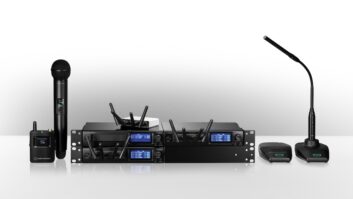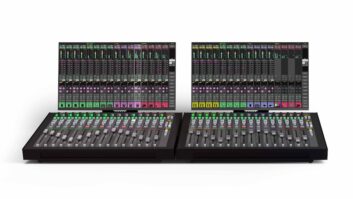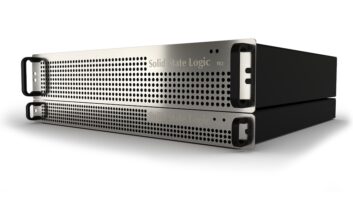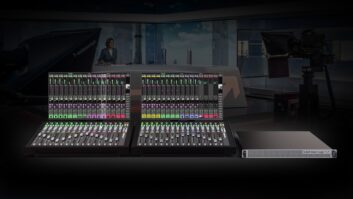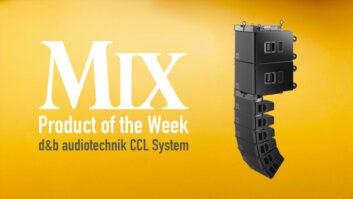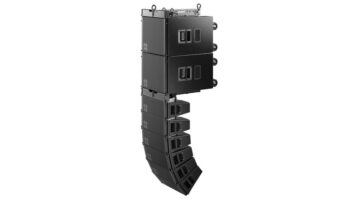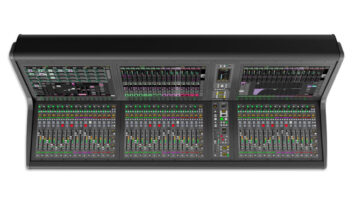When it comes down to tuning an audio system for its intended environment, there are essentially two ways to approach the task. The first follows the empirical path of hard science, which relies on detailed spectrum analysis, acoustical evaluation and corresponding adjustments made on the basis of data gleaned from the test results. Considerably more subjective, the second method relies on a good ear and experience. Practiced commonly by touring sound engineers of all stripes, this latter technique is as much an artistic pursuit as the first is technologically inclined.
As in any human endeavor, there is room for some measure of dispute between hardcore proponents of the two schools of thought. But all arguments aside, one thing is generally agreed upon: Optimizing any system can benefit from both approaches, just as it can from a designer’s ability to choose components that properly address the needs of the application. In a perfect world, after all, the idea is to introduce a system which is so perfectly matched to its surroundings that it will require little, if any, tuning.
BLUE MAN SHRINKS TO FITThe Blue Man Group arrived in Las Vegas earlier this year to begin a five-year run at the main showroom in the Luxor, whose design was inspired by Sid Grauman’s Egyptian Theater in Hollywood (sister venue to the fabled Grauman’s Chinese Theater). Occupying a single level, the fan-shaped venue seats 1,400 and features continuous raked seating broken only by a single center aisle.
When they first moved into the Luxor, the Blue Man production group identified two major obstacles. First, the King Tut ambience of the showroom didn’t come anywhere close to complementing what Blue Man is all about. Second, the group had always cultivated an intimate, in-your-face presence, and for that reason had come to enjoy smaller, 600- to 800-seat venues such as those they appeared in while playing Boston, New York and Chicago.
Modifying the room’s Egyptian motif to suit Blue Man needs was easy enough-a black velour-like material was liberally applied to all the walls from floor to ceiling. “That significantly deadened the whole environment,” says Michael Cusick of Specialized Audio-Video Inc. (SAVI), “and played into the whole audio production concept of Blue Man, which is to provide every seat in the house with near-field monitoring quality.”
Based in Clifton Park, N.Y., SAVI is a rental and design/ build contracting concern that has been active on the Las Vegas show scene for the last seven years, beginning with its work for Starlight Express in 1993. No strangers to the Luxor showroom (the firm installed a turnkey house system there only two years ago), SAVI worked closely this time out with Blue Man’s Todd Pearlmutter and Ross Humphrey to implement a design that would reduce the distance between the audience and the performers, effectively shrinking the room in a psychological sense to bring an air of immediate audio presence to the performance.
For primary audio sources, SAVI installed twin stereo clusters on each side of the proscenium. Each cluster consisted of four EAW SB1000 double-18 subwoofers stacked vertically in a custom concrete enclosure along with three EAW KF755 and three EAW KF750 full-range cabinets. Helping to account for the desired “immediate presence” in no small way, a delayed array of KF755s and EAW’s SB750 subwoofers was positioned midway in the room. Five surround clusters of corner-mounted arrays were outfitted with short and long-throw EAW components from the company’s ASV Series. The diagonally crossfiring scheme in this 5.1 arrangement was completed with a behemoth 3,000-pound overhead center cluster containing four ASV7932 cabinets and four EAW BH822 super-subs.
Under Cusick’s direction, the SAVI crew began the tuning process by accessing the system’s ten XTA digital processors. Stuffed to the gills with parametric EQ, delay, limiting and numerous other functional capabilities, the XTA units were interfaced to a laptop PC out in the room using XTA’s RS-485 network cabling. Joining Cusick and crew out front was another laptop running SIA-Smaart acoustical measurement software.
“We loaded the manufacturer’s suggested loudspeaker settings into the XTA processors,” Cusick relates, “and then, using Smaart at various mic positions we had set up in the room, we analyzed the output of each speaker and optimized its performance for the room. Using this process, we spent several days tuning until the entire system was flat. Then we handed it over to the Blue Man organization.”
Next, behaving as one would in live touring conditions, the Blue Man staff, employing Klark Teknik DN3600 11/43-octave equalizers, went through the system again, tuning it largely by ear. “They brought about a certain change and alteration in color, which we couldn’t have necessarily done,” Cusick admits. “Our completely scientific approach served as the foundation for the Blue Man group’s methods, which gave everything its emotion. It was an interesting combination.”
The end results of these joint efforts brought a transparent sense of clarity to the act, with the desired immediate presence. “There are times during the show when we can measure close to 110 dB in the audience,” Cusick adds. “But with the way gain is used, you never get fatigued or really even become aware that you’re being bombarded with sound. The dynamics are continually in flux, with the high volumes never peaking long enough to wear you out. Although everything is indeed in-your-face, no one walks out of here feeling that the show was too loud.”
REAL-WORLD LUXURIESThe Marriott Lincolnshire Theater is one of Chicagoland’s premier stages for world-class theater. Recently given the task of upgrading the venue’s audio, house sound designer David Lewis enlisted the talents of New York-based Duncan Edwards to breathe new aural life into the room. A veteran of Broadway, touring and regional theatrical productions, as well as musicals of all description, Edwards has also contributed his design and engineering talents to projects as large as 100,000-seat stadiums.
With seating for 882 people, the Marriott Lincolnshire’s “in-the-round” floor plan features four fan-shaped seating sections. In bringing new sound to the environment, Lewis and Edwards jointly penned a design based around modular, self-powered components from Meyer Sound. Considerations for the room’s tuning process effectively began with the creation of the distributed system’s 11 clusters, each of which was composed of a single Meyer Sound UPA-1P at the top and a single Meyer Sound UPM-1P on the bottom. Spaced evenly around the perimeter of a ceiling-mounted grid, each of these arrays receives signals from a single matrix output. A single USW-1P subwoofer also from Meyer Sound resides above three of these clusters, each of which receives its share of the program from an auxiliary send. Providing fill for the first two rows of seating is an inner ring of UPM-1Ps fed by an additional matrix output.
Bi-amped with a single 12-inch transducer at the bottom giving way to a high-frequency 3-inch compression driver, the UPA-1P cabinet has a frequency range extending from 60 to 16k Hz, and cuts a generous swath across the Marriott Lincolnshire’s intended area of coverage measuring 100o horizontally by 45o vertically. Physically smaller in size, the UPM-1P runs from 60 to 22k Hz and leaves a sizable 100o by 100o mark on the floor thanks to its bi-amped, three-way configuration employing dual 5-inch conical drivers and a 1-inch titanium high-frequency transducer. Bringing up the extreme low end, the USW-1P subs range from 32 to 180 Hz, dispersing their sound in a booming pattern measuring 360o horizontally by 180o vertically.
By Edwards’ estimation, selecting components with optimal coverage patterns for the room was vital, especially given the fact that the distance from the house loudspeaker grid to the back row of seats in most places is only 25 feet. Opting for low-Q devices distributed in line arrays as opposed to a high-Q, point-source configuration, the system proved capable of meeting the challenges of the room’s steep vertical coverage requirements while still providing wide, even, horizontal coverage throughout the entire space.
Using Meyer Sound’s SIM System II, Edwards began the system tuning process by making phase, frequency response and dB/SPL measurements at various locations within the theater. To gain a more complete picture, he also verified the frequency response, phase, distortion characteristics and gain structure of the supporting electronic components. Once this data was collected, he examined the phase and levels of the loudspeakers using a number of mics placed in the field of coverage. Next, with the mics repositioned within individual zones mapped out in the room, he tweaked the loudspeakers one box at a time by dialing in the EQ, level and delay sections of four DP200 audio processors provided by XTA Electronics. With EQ established for each individual loudspeaker, Edwards turned his attention to the combined characteristics of the cabinets, making further adjustments to smooth out the frequency and phase response of the system.
“One of the greatest luxuries I had on this job revolved around the fact that I was able to tune the system under actual, real-world working conditions,” Edwards points out. “Preliminary adjustments were made during afternoon cast rehearsals. Much of the actual tuning was performed just before the final orchestra dress rehearsal prior to the system’s evening debut. Based on how the system performed during its first public outing, I made a few more changes. It was fast-paced work, but everything came together nicely in the end.”
CAUGHT IN THE CROSSFIREBack in Las Vegas, spatial issues once again played a large part in the design of a new audio system installed in the House of Blues by Des Plaines, Ill.- based dB Sound. Residing within the Mandalay Bay hotel/casino, the club has what dB Sound’s Harry Witz describes as a “mini-arena” look, with a balcony providing seating along its sides as well as front to back, all above a main floor and bar area. Slated to receive an audio upgrade as part of a sweeping corporate plan that also had dB Sound installing new systems in Chicago and New Orleans House of Blues locations, the HOB Las Vegas, like its Mississippi delta and Midwestern counterparts, became the recipient of an X-Array rig from Electro-Voice.
To adequately bring coverage to the HOB Las Vegas’ intimate seating arrangement-which, on the main floor, comes right up to the sides of the stage-Witz relied upon computer modeling to deploy a workable design. Ultimately discovering that flown line arrays arranged in a “crossfire” configuration on each side of the proscenium (i.e., the house left array is aimed at the right rear corner of the room and vice versa) would provide the best coverage, he selected compact XCN, XCB and XDS components from the X-Array line.
A mid/high box, the XCN (the “N” stands for near-field) cabinet is 23 inches square in its face, yielding a 60o by 40o pattern. Outfitted with a single 18, the XCB is a bass cabinet identical in size to the XCN. As a supplement to the low end, the XDS subwoofer is instrumental in bringing true four-way performance to the system.
“If you don’t stick your neck out once in a while and try something other than the conventional, all you’re ever going to wind up with are conventional results,” Witz says of his unorthodox design. “Now I’m not about to suggest that this is the most revolutionary way to set up a P.A., but what I will say is that in a smaller venue like this, where seating is pretty close, this crossfire arrangement works better, because it’s the best way to ensure that everything in the area of coverage is of an equal distance from the arrays.”
Having completed a number of X-Array installations, Witz has found that during the tuning process, beyond selecting the appropriate box, all one needs to worry about is balancing the output levels. “And that can easily be done with an analyzer,” he notes. “From there, it’s wise to locate any problematic feedback areas in the room-all venues have places where energy tends to get excited-and then notch those frequencies out. You do this by setting up vocal mics in various test locations, and then bring up the system gain and see if it breaks open. Look at your analyzer again to discover the offending frequency, then simply notch it out.”
Outside of dealing with routine tuning issues during the project, the installation crew was met with a unique problem frequently encountered with X-Array rigs: the tendency of visiting engineers to mix too loud when using the system. “We’ve found out over the past couple of years that many people have a tendency to maintain an overly loud house mix with these systems because they are so clean,” Witz explains. “Volume is often perceived from distortion, and distortion is often perceived as volume. So if an engineer can’t get the system to go into breakup mode, he just keeps getting louder and louder.”
HOB Corporate Production Manager Aaron Levine solved this dilemma at HOB Las Vegas rather handily by mounting X-Array XCN and XCB cabinets at stage level and aiming them right at the FOH mix position. “That gives whoever’s at the console a little extra dose of their own medicine,” Witz says with a mischievous chortle. “With the extra boxes onstage in Las Vegas, mixing levels at the House of Blues have gone down by 10 or 15 dB.”
IT’S ALL PHYSICSPacific Bell Park is the new home of the San Francisco Giants. A dedicated space for baseball, the open-air stadium stands in San Francisco’s China Basin district south of Market Street at Third and King. Seating 40,000 fans for both day and night games, the park opened its gates to the public for the first time this year at the end of March for an exposition game just prior to the regular season. Built using a spec drawn up by Dallas-based WJHW, the stadium’s distributed sound reinforcement system was installed by Pro Media, a contracting firm based in El Sobrante, Calif.
With WJHW’s Ron Baker supplying experienced advice and general counsel, Pro Media Director of Engineering Matthew Hock guided the project to a successful conclusion using a design based upon custom components supplied by JBL and driven by QSC Powerlight amps under QSC control. In total, 17 Type Nine CDN-3225 horn/driver combinations serve as the ballpark’s “big guns.” Mounted atop the upper deck, they are the powerful, long-throw figures to which the arrival times of all other loudspeaker devices in the park are timed.
Central among the elements comprising each Type Nine array is a JBL 2490H mid-frequency compression driver with a 3-inch exit throat coupled to a large-format 60×40 horn. A horn-loaded JBL 2447 driver takes care of high-frequency chores in the full-range scheme, while four horn-loaded JBL 2206 12-inch woofers serve as the pulse of all things on the bottom end of the equation.
At the outset of the installation, one of Hock’s main concerns was where the originating point sources would be. “When you get into this many sources, and have these long throws,” he says, “you can’t help worrying about clarity. Your biggest weapon in fighting this battle is ensuring that everything is properly timed. And acoustically, your primary goal is to pick the right components, so there won’t be a lot of tuning to do.”
Determining the proper components for the job in this application was influenced by past experience. Having posted good results with the same monstrous JBL arrays at places like Shoreline Amphitheatre (Mountain View, Calif.), Pro Media felt confident bringing them to Pacific Bell Park as well.
To tune the loudspeakers properly within this potentially harsh acoustical environment, Hock used the MediaMatrix X-Frame digital processing from Peavey. Providing delay, dynamic compression and crossover functions, the X-Frame units were programmed based upon the results of extensive acoustical analysis. “Once you program these devices, they control themselves,” Hock adds. “As a safeguard, we additionally made the front end incredibly redundant. The P.A. is not dependent upon any one source of processing for the origination of its signal. That way, if a failure ever occurs, the system can be patched around the crash site, and the show goes on.
“It’s all physics here,” Hock says. “We may have DSP processing and computer control these days, but the process of tuning a system of this nature and scope really hasn’t changed that much over the years. There is nothing you can do to beat the simple physics of the matter better than choosing the right loudspeaker devices for the job. Without the power to manage the long throws, time and distance will always prevail.”

